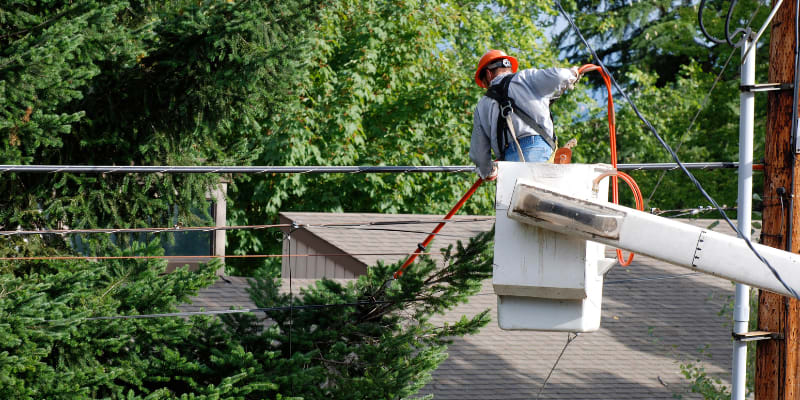Powerlines are dangerous. Do you know how to keep your workers safe?

Powerlines can be deadly. We are reminded of that every time an Ontario worker dies after contacting a powerline, which happened four times last year, according to the Electrical Safety Authority. For arborists and landscapers, electrocution from powerline contact is one of the most severe risks they face.
“Knowing where the powerlines are in relation to the work you are doing is crucial,” says Sean Hooper, Health and Safety Training Consultant with the Infrastructure Health and Safety Association (IHSA). “Landscapers and arboriculture workers are not permitted to work within three metres or ten feet of a powerline. They do not have the required knowledge or training to do so, such as training on Electrical and Utility Safety Rules (EUSR) or the Utility Work Protection Code (UWPC),” he says.
“Powerlines and other electrical equipment are the property of the utility company,” notes Sean. “If a job requires trimming of a tree or hedge that is within ten feet of a powerline, the owner or supervisor must contact the local utility. And the worker who performs the work must be a certified utility arborist.”
Proper planning is essential for safety
Sean explains that locating the powerlines on or near a jobsite is a critical part of the hazard assessment or job safety analysis. During the planning phase, you must identify the location of any powerlines in the work area. "When you break down the job tasks and associated hazards, it will become clear where a certified utility arborist is legally required,” says Sean.
Do not rely on the homeowner or property manager to tell you where the powerlines are located. As the employer or supervisor, you need to do your due diligence. Contact the utility company and complete a thorough inspection of the work area before any work starts. “Powerlines could be hidden behind overgrown hedges or trees,” cautions Ryan Dick, Health and Safety Consultant with Workplace Safety & Prevention Services (WSPS). “Never extend a trimmer or other tool into an area where you do not have full visibility,” he says.
Even when the work area is a safe distance away from powerlines (e.g., more than three metres or ten feet), electricity could still reach workers. “For example, if an arborist is climbing a tree and part of the tree contacts a powerline due to shifting branches or wind, the electricity can reach that worker through the tree,” explains Ryan, as he describes the conductive nature of trees and plants.
Sean provides a similar example of how a worker may be at risk of electrical contact even when they are working a safe distance away. “I could be taking down a tree that is more than ten feet away from any powerline, but when the tree falls, if any part of it touches a powerline on its way down, I could be shocked,” he says. “When supervisors plan the work, they have to consider where cut trees and branches may fall to ensure that there are no powerlines in their path.”
Remember that electricity can jump
“You could be shocked or burned even without actually touching a powerline,” cautions Ryan. He explains that if any part of your body or equipment, such as a ladder or pole trimmer, gets too close to a powerline, any high electrical voltage running through that powerline can jump through the air gap if the conditions are right. “Especially if the equipment you are using contains aluminum or steel,” says Ryan. “Avoid using aluminum or steel ladders because they conduct electricity.”
These examples illustrate the importance of having a certified utility arborist when work near powerlines is required. “In addition to the training, they will have the necessary personal protective equipment to complete the job safely, such as insulated tools and gloves,” says Sean.
Look up and look out when it comes to powerlines. Both Sean and Ryan recommend vigilance. “Stay alert and aware of what’s around you and always follow protocol,” says Ryan. “It could save your life.”
Find out more
-
Watch this short video on Overhead Power Line Hazards Electrical Safety for Landscapers and Arborists (WSPS and IHSA video).
- Visit the WSPS Landscaper and Arborist Safety Centre for training options, compliance information, and free resources.
- Connect with a WSPS expert for assistance with hazard assessment.
Specialized training from IHSA
- Electrical and Utility Safety Rules Training (2024)
- Utility Worker Protection Code (UWPC) Training
- Utility Line Clearing Technician Proficiency Training
- Working at Heights (WAH) - Fundamentals of Fall Prevention (2024)
- Line Clearing - Safety and Awareness (2024)
Resources from WSPS
- Tailgate Talks for the Landscape Industry
- Arborist Industry Safe Work Practices Guide
- Electrical Hazards eCourse
The information in this article is accurate as of its publication date.




